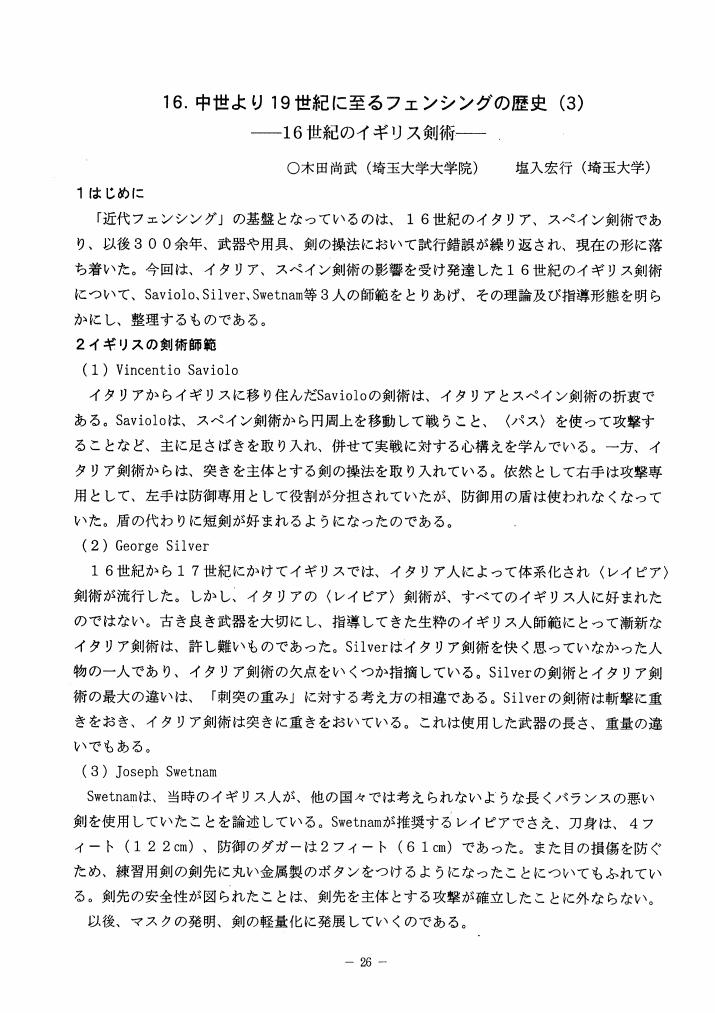11 0 0 0 OA フェンシングの歴史(その1)―16世紀イタリアのフェンシング―
- 著者
- 塩入 宏行 木田 尚武
- 出版者
- 日本武道学会
- 雑誌
- 武道学研究 (ISSN:02879700)
- 巻号頁・発行日
- vol.27, no.2, pp.18-26, 1995-01-31 (Released:2012-11-27)
- 参考文献数
- 48
There seems to exist a prejudice, among the Japanese people, especially those who are not familiar with the history of European style of fencing, that it is too defensive or technical aspect of the fencing is too much emphasized when compared with the offensive Japanese Kendo in which the traditional straight downward cut, for example, the “Kiri-otoshi” or “Hitotsu-gachi” in Itto-ryu school has been respected. It may partly be because of the difference in their fighting styles. Meanwhile, it is an undeniable fact that the term “fencing” derives from “defencing” by losing its suffix “de”, and the French word, “escrime”, which corresponds to the English fencing, comes from the Frankish “skirmjan” meaning defence through “escremie” or “eskermie”.Originally, of course, fencing was really based on the fight of life or death and it is not so deffensive as we Japanese generally suppose. Even after the World war II (in 1958 & 19687), duels with a real sword were fought. They have pursued this art of fencing very seriously.But historically speaking, as Egerton Castle pronounced in his School and Masters of fence, 'Paradoxical as it seems, the development of the “Art of Fence” was the result of the invention of firearms. Its history need not therefore be taken up higher than the fifteenth century.' We may safely say that modern fencing marked its first step is fencing history in the 15th century with the invention of firearms and has developped technically as the weight of the sword deminished. It was not until the latter half of the 17th century that core techniques in modern fencing, such as <parade-riposte> in two times or <on guare position> closing the line of attack, etc. appeared.In this study the authors tried to clarify the characteristic features in styles of four representative masters of fence in the 16th century Italy where systematic teaching of fencing first appeared and the theories of fencing masters were published in printed treatices. Their names are Achille Marozzo, Camillo Agrippa, Giacomo di Grassi and Angelo Viggiani.
9 0 0 0 OA 中世より19世紀に至る西洋剣術の発達(1)
- 著者
- 木田 尚武 塩入 宏行
- 出版者
- 日本武道学会
- 雑誌
- 武道学研究 (ISSN:02879700)
- 巻号頁・発行日
- vol.27, no.Supplement, pp.3, 1994 (Released:2012-11-27)
7 0 0 0 OA 中世より19世紀に至るフェンシングの歴史(3)―16世紀のイギリス剣術―
- 著者
- 木田 尚武 塩入 宏行
- 出版者
- 日本武道学会
- 雑誌
- 武道学研究 (ISSN:02879700)
- 巻号頁・発行日
- vol.29, no.Supplement, pp.26, 1996 (Released:2012-11-27)
6 0 0 0 OA 中世より19世紀に至るフェンシングの歴史(2)
- 著者
- 木田 尚武 塩入 宏行
- 出版者
- 日本武道学会
- 雑誌
- 武道学研究 (ISSN:02879700)
- 巻号頁・発行日
- vol.28, no.Supplement, pp.71, 1995 (Released:2012-11-27)
1 0 0 0 中世より19世紀に至る西洋剣術の発達(1)
- 著者
- 木田 尚武 塩入 宏行
- 出版者
- 武道学研究
- 雑誌
- 武道学研究 (ISSN:02879700)
- 巻号頁・発行日
- vol.27, pp.3, 1994



